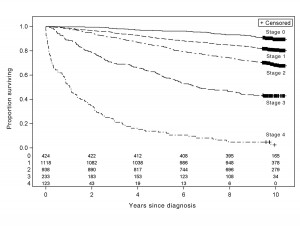When variation is the story
A familiar trope of alternative cancer therapy is the patients who were given just months to live and are still alive years later. The implication is that their survival is surprising and the cancer therapy was responsible. Falling foul of the post hoc ergo propter hoc fallacy isn’t the big problem here. The big problem is that it’s not surprising that some people live a lot longer than the median.
Our intuition for variation is developed on measurements that aren’t like cancer survival. Most adults are pretty close to the average height — very few are more than a foot taller or shorter. Most people in Western countries die at close to the average age: for example, by the NZ life tables, the median life expectancy for NZ men born now is 81 years, and the tables predict half will die between 73 and 88 years.
For many types of cancer, survival isn’t like that. Here’s a graph from a big Canadian study of breast cancer
The median survival for women with stage IV cancer in this group is about a year; half of them are still alive after a year. About half of those are still alive after two years; about half of those are still alive after three years, and some live much longer.
Variation in cancer survival — the long tail — should be welcome, but not surprising. Some people will be alive three, four, five or more years after ‘being given a year to live’. We should be just as cautious about crediting them with finding a cure as we should be about blaming those who died sooner.
Thomas Lumley (@tslumley) is Professor of Biostatistics at the University of Auckland. His research interests include semiparametric models, survey sampling, statistical computing, foundations of statistics, and whatever methodological problems his medical collaborators come up with. He also blogs at Biased and Inefficient See all posts by Thomas Lumley »
